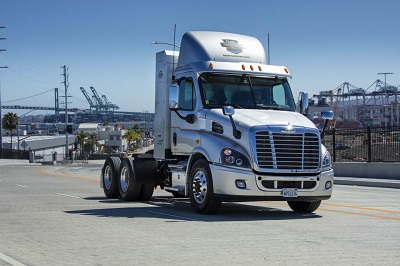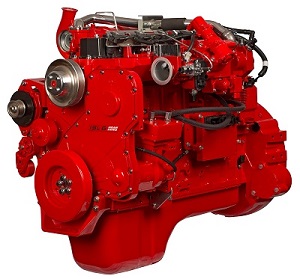Near-Zero Heavy-Duty Truck Emissions
Print this Article | Send to Colleague
Recent Study Shows Clean Natural Gas Engines to Be the Most Likely Path for the Future
The Next Generation Natural Gas Trucks
As a transportation professional in California, you keep on top of technology developments that affect your business. You have probably also noticed the adoption of natural gas in other heavy-duty segments such as transit buses and refuse trucks. The latest compressed natural gas (CNG) technology has arrived for the goods movement sector as well. CNG tank packages now allow for a range of 600 miles or more. The current 11.9 liter natural gas engine is rated up to 400 horsepower and is suited for a broad range of trucking applications. Natural gas is ready for prime time in the trucking industry. And the news is about to get even better.

Game Changer: The Best of Four Possible Pathways
For years, the trucking industry has been a major target for emissions reductions in California. To address this issue, various "zero tailpipe" and "near-zero" technologies have been proposed and developed in recent years for use in heavy-duty transportation, including trucking. Gladstein Neandross Associates (GNA), a clean transportation consultancy based in Santa Monica, California, recently unveiled a new Game Changer Technical White Paper that may help define what the future of truck technology could look like in the United States.
The white paper describes the four fuel and technology combinations that currently hold the most promise to improve air quality and reduce greenhouse gas (GHG) emissions in the United States. They are:
1)Advanced low‑emission internal combustion engines fueled increasingly by renewable natural gas
2)Advanced low‑emission internal combustion engines fueled by renewable diesel
3)Electric‑drive systems powered by batteries
4)Electric‑drive systems powered by hydrogen fuel cells
The Game Changer white paper documents that only one of these fuel‑technology platforms meets all the commercial feasibility and logistics tests to immediately begin this air quality transformation: near‑zero‑emission heavy‑duty natural gas vehicles (NGVs) fueled by increasing volumes of ultra‑low‑GHG renewable natural gas, or "RNG."
"Near-Zero" Natural Gas Engine with Renewable Natural Gas Is the Key
With its long history of producing diesel engines, Cummins is a familiar and trusted name in the trucking industry. Cummins Westport is a joint venture with Westport Innovations and is a worldwide leader in the manufacture and sale of heavy-duty natural gas engines. In 2015, Cummins Westport certified the world’s first heavy‑duty engine at near‑zero‑emission levels. RNG completes a game‑changing emissions proposition by providing the lowest carbon intensity of any heavy‑duty transportation fuel available in the market today. Near-zero-emission natural gas engines using RNG provide a commercially-proven, broad‑based and affordable strategy to immediately achieve reductions in emissions of criteria pollutants, air toxins and GHGs from America’s on‑road heavy-duty vehicle sector. This is not some far off technology in need of further development. Compared to the other near-zero options, the low-NOx and RNG solution has a significant cost advantage. This means that more near-zero trucks can be put on the road for the same given cost, resulting in reduced overall emissions inventory for the fleet. RNG can be used right now, in today’s natural gas engines and is already available at many public CNG stations in California.

Transit and Refuse Applications Today, Heavy Duty Trucking in Just Two Years
The 8.9 liter near-zero engine is best suited for transit and refuse applications and limited trucking applications that travel short-distances or with low payloads. By 2018, Cummins Westport will certify and commercialize a near‑zero‑emission 12‑liter engine to provide diesel‑like performance for tractor‑trailer trucks hauling 80,000 pounds. The combination of new near‑zero‑emission natural gas engine technology and RNG provides the single best opportunity for America to achieve immediate and substantial NOx and GHG emission reductions in the on‑road heavy‑duty transportation sectors.
The Time for Incentive Development is Now
Natural gas vehicles generally cost more than their diesel counterparts. That’s why the role of grants and incentives is critical to encourage steady adoption of NGVs. National, state and local incentive funding programs should be established or strengthened to subsidize the higher costs to deploy these new‑generation heavy‑duty NGVs and help produce and transport RNG where the economics and logistics are most conducive.
Get the Details
Visit the Game Changer website at http://ngvgamechanger.com/ to see the Game Changer video and download the entire white paper or executive summary.
SoCalGas Can Help
To find out if compressed natural gas is right for your operation, contact SoCalGas at (213) 244-5681 or email us at NGVinfo@semprautilities.com. We have dedicated account executives all over Southern California who can connect you with unbiased information and resources for vehicles, grants and incentives, station building and more.
Article provided by SoCalGas, CTA Executive Circle Club Partner. The views expressed in this article reflect the views of the author and do not necessarily reflect the views of the California Trucking Association.

